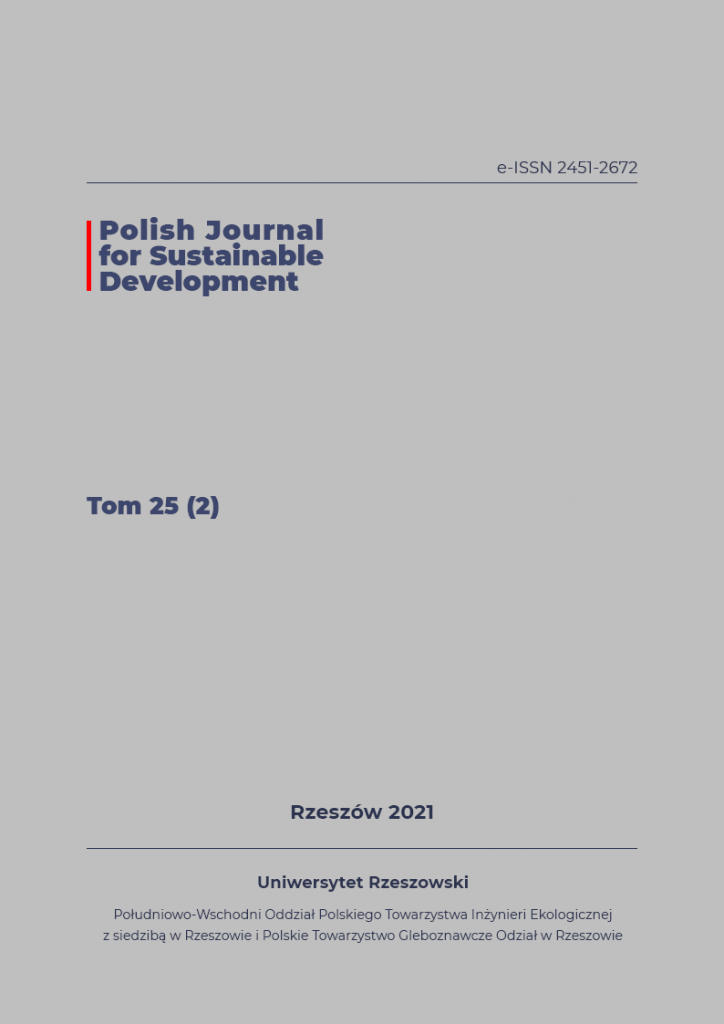Municipal waste management in the Pogórze Dynowskie
DOI:
https://doi.org/10.15584/pjsd.2021.25.2.5Keywords:
municipal waste, waste menagement, morfological groups, Pogórze DynowskieAbstract
This article compares the theoretical estimate with the actual amount of municipal waste received in the area of five rural municipalities that are part of the local Association of Dynów Foothills Communes (Związek Gmin Pogórza Dynowskiego, Podkarpacie Province in Southeastern Poland). The theoretical waste mass in 2019 calculated on the basis of statistical indicators of waste generation was even 60% higher than the actual mass of the collected waste. Theoretically, 27% of the waste generated in the studied area should subsequently be subject to the different recycling processes, while the waste database showed that only 14% of the waste mass was collected separately in morphological categories such as: paper and cardboard, glass, plastics, metals and biodegradable materials. Moreover, in all of the considered municipalities WEEE, bulky waste, and mixed packaging waste were collected, which in total accounted for 30% of selectively collected waste.
Downloads
References
Bank Danych Lokalnych. Główny Urząd statystyczny 2020. Data wejścia: 15.01.2021.
Bergel T., Kaczor G. 2006. Szacowana a rzeczywista ilość odpadów komunalnych zbieranych w gminach wiejskich. Infrastruktura i Ekologia Terenów Wiejskich. 3(2). 5-16.
Directive (EU) 2018/ of the European Parliament and of the council of 30 May 2018 amending Directive 2008/98/EC on waste [PE/11/2018/REV/2].
Generowicz A., Gaska K. 2014. Research on waste generation indicators for 40 thousand inhabitants community. Archives of Waste Management and Environmental Protection. 16. 67-74.
Ichinose D., Yamamoto M. 2011. On the relationship between the provision of waste management service and illegal dumping. Resource and Energy Economics. 33. 79-93.
Jędrczak A., Szpadt R. 2006. Określenie metodyki badań składu sitowego, morfologicznego i chemicznego odpadów komunalnych. [dok. elektr.: http:// www.mos.gov.pl data wejścia 10.11.2021].
Kostecka J., Koc-Jurczyk J., Brudzisz K. 2014. Waste management in Poland and European Union. Archiwum Gospodarki Odpadami i Ochrony Środowiska. 16. 1-10.
Norma BN-87/9103-04: Unieszkodliwianie odpadów miejskich. Metody oznaczania wskaźnika nagromadzenia.
Ustawa z dnia 11 sierpnia 2021 r. o zmianie ustawy o utrzymaniu czystości i porządku w gminach, ustawy - Prawo ochrony środowiska oraz ustawy o odpadach [Dz.U. 2021 poz. 1648].
Ustawa z dnia 13 września 1996 r. o utrzymaniu czystości i porządku w gminach [Dz.U. 1996 nr 132 poz. 622].
Ustawa z dnia 14 grudnia 2012 r. o odpadach [Dz.U. 2013 poz. 21].
Ustawa z dnia 27 kwietnia 2001 r. Prawo ochrony środowiska [Dz.U. 2001 nr 62 poz. 627].
Downloads
Published
Issue
Section
License
Copyright (c) 2021 Polish Journal for Sustainable Development

This work is licensed under a Creative Commons Attribution-NonCommercial-NoDerivatives 4.0 International License.


